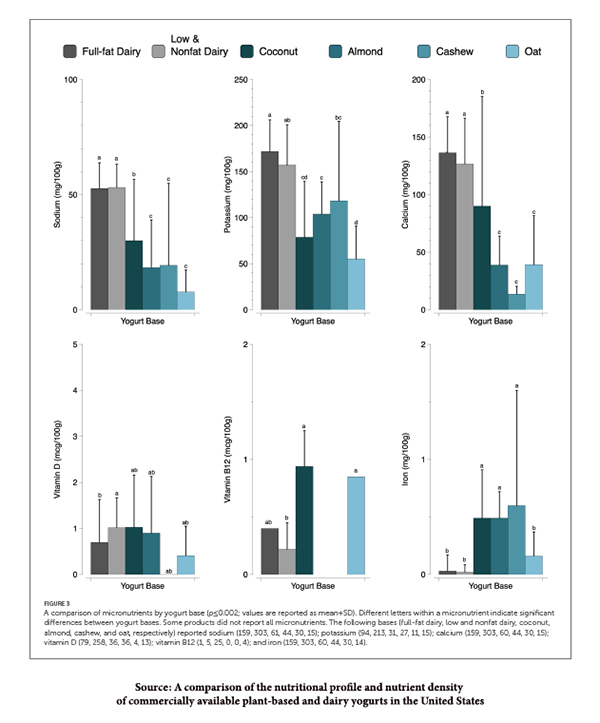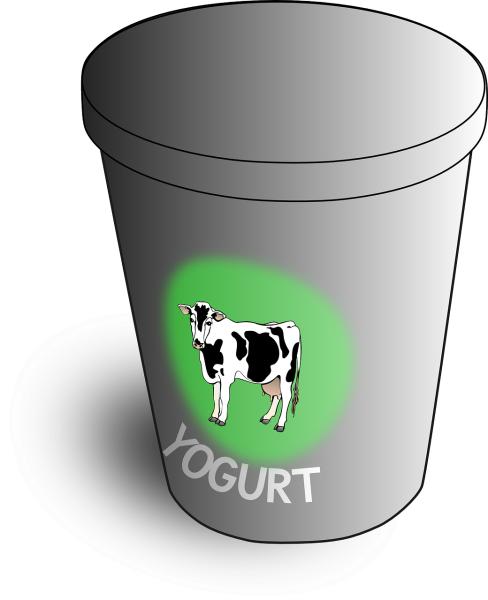Plant-based yogurt is marketed as environmentally friendly, requiring less land for production and avoiding those methane-producing natural fermenters, cows (and the occasional sheep or goat). Only about half of yogurt purchasers recognize its “environmental advantages,” most purchase the product because it is “healthy” – and for those “seeking health,” as opposed to nutrition, a long list of ingredients, especially additives, suggest the product is not so healthy. That is a problem for plant-based yogurts, but they contain additives and supplements.
The research consisted of a database of yogurts, dairy, and plants and their labeling information, cross-referenced with the Nutrient Rich Foods (NRF) Index. The NRF scores a food’s value based on nutrient content in relation to calories. Good nutrients include protein, fiber, calcium, iron, potassium, and Vitamin D; “bad” nutrients include saturated fat and total sugar.

Depending upon the base product of the yogurt, plant or dairy, almond or cow, etc., the amount of macronutrients varied quite a bit. If you are looking for calories, dairy supplies them as carbohydrates, and coconut-based yogurt provides them through fats.
 There were similar differences in comparing the micronutrients, especially for sodium and calcium. Plant-based yogurts were more frequently “fortified” with calcium, a natural component of dairy-based yogurt. Vitamin B12 and iron, two necessary supplements to a vegan diet, were found in plant-based yogurts.
There were similar differences in comparing the micronutrients, especially for sodium and calcium. Plant-based yogurts were more frequently “fortified” with calcium, a natural component of dairy-based yogurt. Vitamin B12 and iron, two necessary supplements to a vegan diet, were found in plant-based yogurts.
Unsurprisingly, the composition of the final product, yogurt, is significantly influenced by the base upon which it is built. But there is another factor at play here that is definitely worth mentioning.
“We observed that these nutritional differences in plant-based yogurts are partly due to the use of a variety of ingredients, which help to deliver desirable sensory and textural properties.”
Taste and mouth feel
Sugar-containing “sweeteners” like fruit puree or syrup are added to plant-based yogurts to mask the “unpleasant sensory attributes of plant proteins.” And those plant proteins do not contain all of the essential amino acids. The authors suggest a hybrid yogurt, part animal, part plant, to complete the protein profile. A diet that “reduces or removes dairy may create a risk of inadequate consumption of micronutrients such as calcium, vitamin D, potassium, and vitamin B12,” requiring additional fortification.
Mouth feel is, as it sounds, the feeling, the texture of food in our mouths. No one wants crunchy yogurt (I think), and few of us want liquid meat. To enhance “consumer acceptance” of plant-based yogurt, we must increase its viscosity or thickness; to do that, manufacturers add gums and starches.
The researchers using that previously mentioned NRF scoring system ranked the yogurts.
“…almond and oat yogurts are more nutritionally dense than dairy yogurts … [and their] higher NRF scores can be attributed to their low levels of total sugar, sodium, and saturated fat.”
But that high score comes with a price: adding supplements and additives. According to the NOVA food processing classification, adding supplements turns a wholly unprocessed food, including a dairy-based yogurt, into a “processed” food. Adding those gums and starches to make those plant-based yogurts palatable makes plant-based yogurts much closer to the “ultra-processed foods.”
Plant and dairy-based yogurts are similar, not the same, and that is alright. If you must use solely plant-based yogurts because of your dietary choices, you will need supplements, but you already knew that. Adding plant-based yogurts into an already balanced, diverse diet is nutritionally sound for most of us. Whether we can eat our way to significantly fewer greenhouse gases by switching to plant-based yogurts is more aspirational than real.
Source: A comparison of the nutritional profile and nutrient density of commercially available plant-based and dairy yogurts in the United States Frontiers in Nutrition DOI: 10.3389/fnut.2023.1195045




